
Mount Diablo is a mountain of the Diablo Range, in Contra Costa County of the eastern San Francisco Bay Area in Northern California. It is south of Clayton and northeast of Danville. It is an isolated upthrust peak of 3,849 feet, visible from most of the San Francisco Bay Area. Mount Diablo appears from many angles to be a double pyramid and has many subsidiary peaks. The largest and closest is North Peak, the other half of the double pyramid, which is nearly as high in elevation at 3,557 feet (1,084 m), and is about one mile northeast of the main summit.
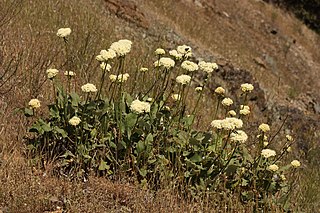
Eriogonum is a genus of flowering plants in the family Polygonaceae. The genus is found in North America and is known as wild buckwheat. This is a highly species-rich genus, and indications are that active speciation is continuing. It includes some common wildflowers such as the California buckwheat.
Morgan Territory is an historic ranching area on the east side of Mount Diablo in San Francisco East Bay's Contra Costa County. It was named after Anglo-American pioneer Jeremiah Morgan, a migrant from Alabama and Iowa who acquired 2000 acres and developed a ranch here, starting in 1857.
Mary Leolin Bowerman was an American botanist, co-author of The Flowering Plants and Ferns of Mount Diablo, California; Their Distribution and Association into Plant Communities, and the co-founder of Save Mount Diablo. She helped to preserve tens of thousands of acres of Mount Diablo in the San Francisco East Bay before dying at age 97. In 1936 she was the last person to record the Mount Diablo buckwheat Eriogonum truncatum, until it was rediscovered nearly seventy years later on May 10, 2005. In 1978 the manzanita Arctostaphylos bowermaniae was named in her honor.

Eriogonum fasciculatum is a species of wild buckwheat known by the common names California buckwheat and flat-topped buckwheat. Characterized by small, white and pink flower clusters that give off a cottony effect, this species grows variably from a patchy mat to a wide shrub, with the flowers turning a rusty color after blooming. This plant is of great benefit across its various habitats, providing an important food resource for a diversity of insect and mammal species. It also provides numerous ecosystem services for humans, including erosion control, post-fire mitigation, increases in crop yields when planted in hedgerows, and high habitat restoration value.

Eriogonum arborescens is a species of wild buckwheat known by the common name Santa Cruz Island buckwheat.
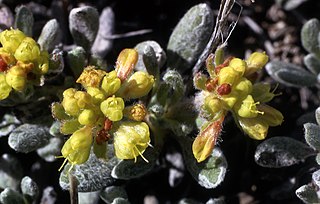
Eriogonum caespitosum is a species of wild buckwheat known by the common name matted buckwheat, mat buckwheat, or cushion desert buckwheat. It is a common perennial plant native to the western United States from California to Montana, especially the Great Basin. Flowering early in the summer, it is also cultivated as a rock garden plant.

Eriogonum dasyanthemum is a species of wild buckwheat known by the common name chaparral buckwheat. This plant is endemic to California where it is limited to the Northern Coast Ranges, but it is quite common in its native range.
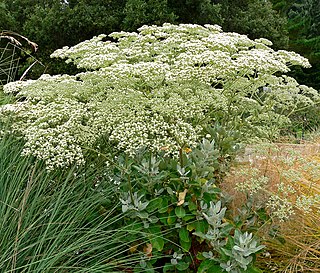
Eriogonum giganteum, with the common name St. Catherine's lace, is a species of wild buckwheat in Southern California.

Eriogonum ovalifolium is a species of wild buckwheat known by the common name cushion buckwheat. It is native to western North America from California to Alberta, where it is a member of many plant communities in varied habitats, including the sagebrush steppe and alpine regions.

Eriogonum pyrolifolium is a species of wild buckwheat. It is native to western North America, from British Columbia to the high mountains of California.

Eriogonum strictum is a species of wild buckwheat known by the common name Blue Mountain buckwheat. It is a common plant of western North America from northern California to British Columbia where it is found along rocky slopes and scrubland. It flowers early in the summer.
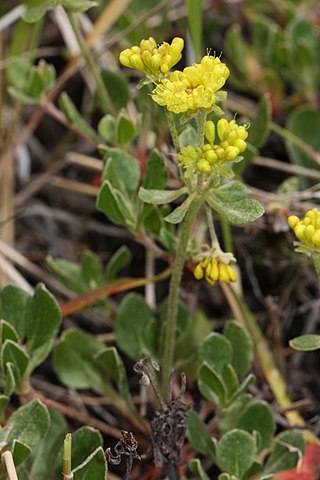
Eriogonum umbellatum is a species of wild buckwheat known by the common name sulphurflower buckwheat, or simply sulphur flower.

Eriogonum flavum is a species of wild buckwheat.

Eriogonum heracleoides is a plant of western North America that has many flowering clusters which are usually cream colored, or off-white. It can usually be found in rocky areas, such as sagebrush deserts and Ponderosa pine forests. Parsnipflower buckwheat is in the genus Eriogonum and the family Polygonaceae, which is a family of plants known as the "knotweed family". It inhabits much of the western part of the United States and southern British Columbia.

Eriogonum brachyanthum is a species of wild buckwheat that is commonly known as shortflower buckwheat. It is native to eastern California and western Nevada, particularly the Mojave Desert region, where it is common to abundant, and even sometimes weedy. It is also known from southern Oregon. The plant grows in sandy habitats such as desert flats and sagebrush. It also grows in pinyon-juniper and montane conifer woodlands. It is an annual herb that grows 30 to 40 centimeters tall. Leaves are located at the base of the stem, woolly, and oval or rounded in shape. The top of the stem is occupied by a branching inflorescence bearing many widely spaced clusters of flowers. Each individual flower is about a millimeter wide and light yellow in color. Flowers bloom from April to November.

Eriogonum contiguum is an uncommon species of wild buckwheat. It is commonly known as Reveal's buckwheat and annual desert trumpet. It is native to Death Valley in California and adjacent sections of Nevada. It is commonly found in Death Valley National Park and Mojave National Preserve. Eriogonum contiguum grows in sandy to gravelly flats and slopes, or rocky hills, and lower bajadas with Atriplex species. It is an annual herb which produces an erect, spreading stem up to about 30 centimeters high. Leaves are basal, small rounded, and woolly. The many scattered inflorescences are small, compact clusters of tiny hairy yellow flowers. Flowers bloom April to June. It is threatened due to habitat degradation by off-road vehicles, competition with exotic plant species, trampling, grazing, and erosion.
Eriogonum deserticola is a species of wild buckwheat known by the common name Colorado Desert buckwheat.

Eriogonum sphaerocephalum is a species of wild buckwheat known by the common names rock buckwheat and round-headed desert buckwheat. It is native to the western United States.
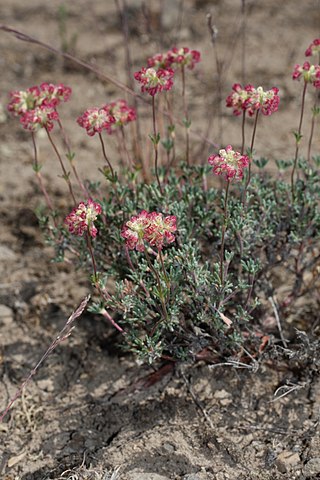
Eriogonum thymoides is a species of flowering plant in the buckwheat family known by the common name thymeleaf wild buckwheat, or simply thymeleaf buckwheat.

















